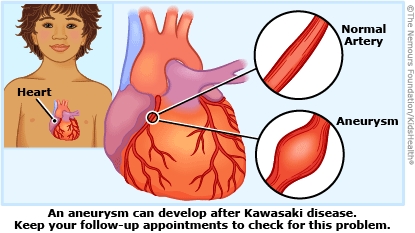Kawasaki disease causes inflammation (swelling) of the arteries (blood vessels). Most children who have Kawasaki disease and get treatment recover fully. But some can develop an aneurysm (bulging of the wall in an artery) or other heart problems. Your child's cardiologist (heart doctor) checked your child for heart problems by doing an echocardiogram (ultrasound of the heart) and possibly other tests. They will talk to you about the test results and what to do next.

Follow your health care provider's instructions for:
- Taking any medicines. Most kids with Kawasaki disease take aspirin for at least 4–6 weeks, though some take it longer.
- Getting the flu shot for your child and other household members. A child or teen who gets the flu while taking aspirin may be at higher risk for Reye syndrome, a rare but serious illness.
- Avoiding people with chickenpox, especially if your child did not get the chickenpox shot. Your child may be at higher risk for Reye syndrome if they get chickenpox while taking aspirin.
- Any changes to your child's vaccine schedule.
- When your child can return to school, sports, and other activities.
- When to follow up. It's very important for your child to see the cardiologist again as instructed so they can continue to watch for any heart problems. Your child may need multiple checkups in the months after having Kawasaki disease and may need echocardiograms or other tests for at least 1 year.
Home Care
- To support your child's overall well-being, help them:
- Eat a healthy diet with whole-grain breads and cereals; lean meats like chicken and other good sources of protein such as fish, eggs, beans, and nuts; and plenty of fresh fruits and vegetables.
- Get plenty of physical activity every day.
- Get enough sleep.

What causes Kawasaki disease? The exact cause isn't known, but it may be related to some types of infections. It doesn't spread from person to person.
What are the symptoms of Kawasaki disease? Usually, the first sign is a fever. Other symptoms — such as eye redness; a pink rash; dry, cracked lips; a swollen tongue with red bumps; sore throat; swollen glands in the neck; and swollen palms and soles of the feet — also can happen. After about 2 weeks, the skin of the hands and feet might peel, and a child can have diarrhea, vomiting, belly pain, or joint pain.
What problems can happen from Kawasaki disease? With treatment, most kids who get Kawasaki disease don't have any lasting problems. Rarely, even with treatment, these problems can happen:
- aneurysms of the arteries that send blood to the heart (this can lead to blood clots)
- swelling of the heart muscle
- heart valve problems
- arrythmia (abnormal heartbeat)
How is Kawasaki disease treated? Treatment includes:
- intravenous (IV) immune globulin (IVIG), which contains proteins that lower inflammation in the body. It helps the fever and other symptoms of Kawasaki disease go away and lowers the risk of aneurysms and other heart problems.
- aspirin, and sometimes steroids, to ease inflammation. Aspirin will also help prevent blood clots.
- regular visits with the cardiologist to check for and treat any heart problems




